What is endocrine system?
The endocrine system is a chemical messaging system that comprises feedback loops of hormones released by the internal glands of an organism directly into the circulatory system, regulating distant target organs. It is a way of communication within the human body. It consists of a group of cells that secrete chemicals called hormones, which in turn travel through the bloodstream to then bind to special receptors on the target cells.
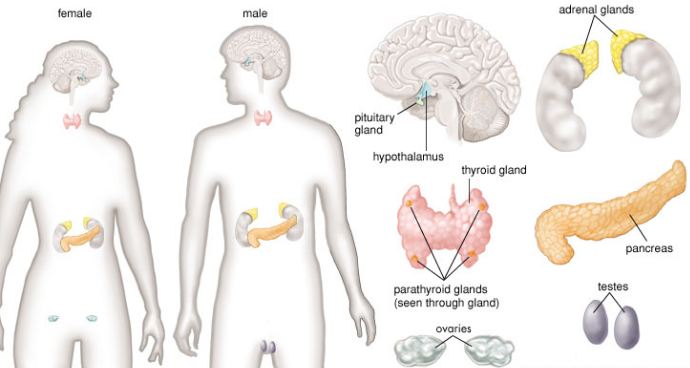
In fact, the endocrine system was called this name because these glands Unlike Sebaceous glands and sweat glands that make up the so-called exocrine system, the ducts do not release secretions, while the endocrine glands secrete their hormones directly into the fluid, surrounding it, and then it travels through the interstitial fluid into the blood vessels.
It is worth noting that endocrine hormones work to regulate many vital functions in the human body, most notably: growth, metabolism, sexual growth, and others.
Functions and parts of the endocrine system
The endocrine system consists of a group of glands as mentioned above, and each of them secretes specific hormones, and the statement of these glands is as follows:
1- Hypothalamus
(English: Hypothalamus),

an area located in the lower part of the brain, and secrete hormones that stimulate or discourage the secretions of the pituitary gland, as this is a region of great importance in the organization of the process of metabolism in the body, in addition to its temperature, as well as Feeling full.
- The hypothalamus also secretes a hormone called Somatostatin, which stops the growth hormone from the pituitary gland.
- Corticotropin-releasing hormone (in short CRH) is also released from the hypothalamus to stimulates the anterior pituitary for releasing adrenocorticotropic hormone (ACTH).
2- Pituitary gland
The pituitary gland is the most prominent endocrine gland because it secretes hormones through which it actively controls other endocrine activity. The pituitary is located at the bottom of the brain, the size of which does not exceed the size of a pea, and the hypothalamus controls the activity of the pituitary. It is worth explaining that the pituitary gland consists of two parts, anterior and posterior, each of which secretes specific hormones, and the most prominent of these hormones is as follows:
Hormones of the anterior part of the pituitary gland
The most important of these hormones can be summarized as follows:
- Growth hormone: Somatotropin, also known as human growth hormones (hGH or HGH) is a peptide hormone
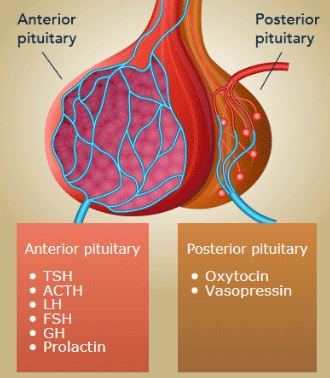
Pituitary gland lobes with its hormones that stimulates growth, cell reproduction, and cell regeneration in humans and other animals.
- Thyroid-stimulating hormone: Thyroid–stimulating hormone (also known as thyrotropin, abbreviated TSH) is a hormone that stimulates the thyroid gland to produce thyroxine (T4), and then triiodothyronine (T3) to stimulates the metabolic rate of almost every tissue in the body.
- Adrenocorticotropic hormone (ACTH) is made in the pituitary gland. ACTH stimulates the release of another hormone called cortisol from the cortex which is the outer part of the adrenal gland.
- Luteinizing hormone (follicle-stimulating hormone): It is produced by gonadotropic cells in the anterior pituitary lobe. In females, its rise level triggers ovulation and development of the corpus luteum. In males, where it is called interstitial cell-stimulating hormone, stimulates Leydig cell for the production of testosterone.
- Prolactin: Prolactin stimulates breast milk production in females.
Hormones of the anterior part of the pituitary gland
In the posterior part of the pituitary gland, there are two hormones.
- Anti-diuretic hormone (ADH): This controls the rate of water release from the kidneys. This hormone stimulates kidneys to increase water absorption in the blood.
- Oxytocin: Oxytocin is involved in a variety of processes, such as contracting the uterus during childbirth and stimulating breast milk production.
In fact, the secretions of the posterior part are not controlled by the hypothalamus, and the production of these hormones takes place in the brain and then moves to the posterior part of the pituitary gland for storage only.
3- Thyroid Gland
The thyroid is a small gland, about 2 inches (5 centimeters) in diameter, which is located just under the skin under Adam’s apple in the neck. The two halves (lobes) of the gland are connected to the middle (called the isthmus), giving the thyroid gland the shape of a bow tie.
Functions of the thyroid gland
The thyroid gland secretes thyroid hormones, which control the rate of body metabolism. Thyroid hormones influence the metabolic rate in two ways:
- By stimulating almost every tissue in the body to produce protein
- By increasing the amount of oxygen that cells use
Thyroid hormones affect many vital functions of the body, such as heart rate, the speed at which calories are burned, skin maintenance, growth, heat production, fertility, and digestion.
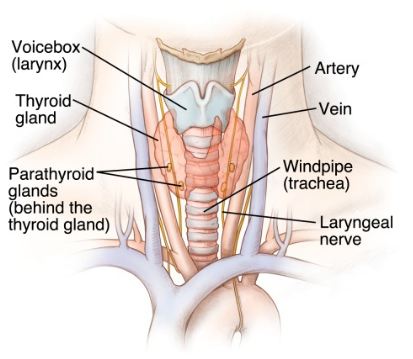
Aging causes changes in the thyroid gland
Aging itself has only minor effects on the thyroid gland and thyroid hormones. As people age, the thyroid gland shrinks and travels further down the neck. The level of the thyroid hormone triiodothyronine (T3) may drop slightly, but the speed of your vital functions changes very little. However, thyroid disorders become more common with aging.
Disorders that affect thyroid function
These include hyperthyroidism and hypothyroidism. These disorders often cause symptoms that are easily mistaken for symptoms of other conditions or even as signs of aging.
The increase or decrease in thyroid function can significantly worsen the way an older person feels and can significantly decrease the ability to perform daily activities.
Screening for hyperthyroidism and hypothyroidism in the old age is helpful. Some experts recommend measuring the level of thyroid-stimulating hormone in the blood in people over 65 every 5 years.
Thyroid hormones
The thyroid hormones are
- T4: Thyroxine (also called tetraiodothyronine)
- T3: Triiodothyronine
- Calcitonin
T4, the main hormone produced by the thyroid gland, has little or no effect on speeding up the body’s metabolism. Instead, T4 is converted to T3, the most active hormone. The conversion of T4 to T3 occurs in the liver and other tissues. Many factors control the conversion of T4 to T3, including the body’s needs at any time and the presence or absence of disease.
Most T4 and T3 in the bloodstream are linked to a protein called thyroxine-binding globulin. Only a few of T4 and T3 circulate freely in the blood. However, it is this free hormone that is active. When the free hormone is used by the body, part of the bound hormone is released from the binding protein.
Iodine requirement
To produce thyroid hormones, the thyroid gland needs iodine, an element found in food and water. The thyroid gland traps iodine and turns it into thyroid hormones. When thyroid hormones are used, part of the iodine in the hormones is released, returns to the thyroid gland and is recycled to produce more thyroid hormones. Oddly enough, the thyroid gland releases slightly less thyroid hormone if it is exposed to high levels of iodine that is carried there in the blood.
Calcitonin
The thyroid gland also produces the hormone calcitonin, which can contribute to bone strength by helping calcium to be incorporated into the bones.
How the body adjusts thyroid hormones
The body has a complex mechanism to adjust the level of thyroid hormones. First, the hypothalamus, located just above the pituitary gland in the brain, secretes the hormone-releasing thyrotropin, causing the pituitary gland to produce thyroid-stimulating hormone (TSH). As its name suggests, TSH stimulates the thyroid gland to produce thyroid hormones. The pituitary gland slows or accelerates the release of TSH, depending on whether the levels of thyroid hormones circulating in the blood become too high or too low.
4-Parathyroid glands
The parathyroid glands are four small glands in the endocrine system that regulate calcium in our body. The parathyroid glands are located in the neck behind the thyroid, where they constantly monitor and regulate calcium levels in the blood.
The parathyroid glands are normally the size of a grain of rice. Sometimes they can be as big as a pea. The four parathyroids are
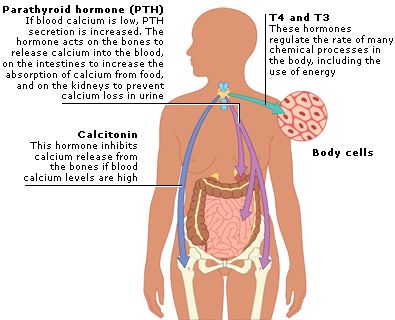
located behind the thyroid gland. Normal parathyroid glands are the color of spicy yellow mustard.
Function
The parathyroid glands control the levels of calcium in our blood, in our bones, and throughout our bodies. The parathyroid glands regulate calcium by producing a hormone called parathyroid hormone (PTH).
Calcium is the most important element in our body (we use it to control many body systems), so calcium is regulated more carefully than any other element. In fact, calcium is the only element with its own regulatory system – the parathyroid glands.
The level of calcium in our body is regulated within a very narrow range so that the nervous and muscular systems can function properly. Parathyroid glands measure the amount of calcium in the blood every minute of every day and if the calcium levels go down a little, the parathyroid glands recognize it and make the parathyroid hormone (PTH) which goes into the bones and removes calcium (removes the calcium vault) and puts it in the blood. When the calcium in the blood is high enough, the parathyroids stop and stop producing PTH.
Overactivity of the Parathyroid glands leads to Hyperparathyroidism
The only major disease of the parathyroid glands is the overactivity of one or more of the parathyroid glands that produce too much parathyroid hormone causing a potentially serious calcium imbalance (too much calcium in the blood). It’s called hyperparathyroidism.
5- Adrenal glands
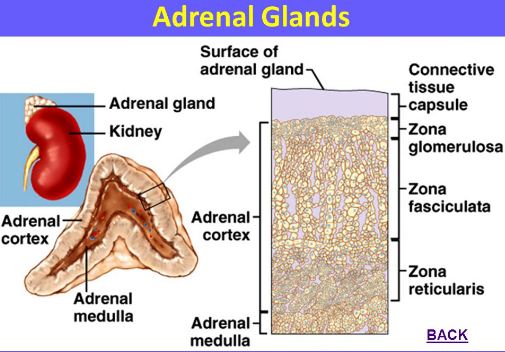
These are two glands located above the kidneys. Each of them consists of two parts, the outermost part called the cortex (Corticosteroids), which is responsible for secreting corticosteroid hormones that regulate several functions in the body, such as metabolism, water and salt balance, the immune system, and sexual activity. The inner part is called the medulla, which secretes catecholamines, such as adrenaline.
6- Reproductive glands
The ovaries
A woman has 2 ovaries. The ovaries are located on each side of the uterus, just below the opening of the fallopian tubes. These are the tubes that extend from the uterus to near the ovaries.
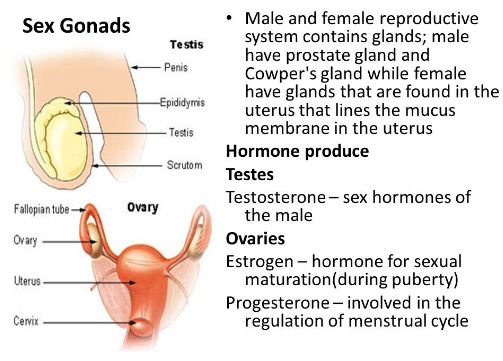
Hormones: The ovaries contain the ovules necessary for reproduction. They also produce hormones, estrogen, and progesterone. These affect many of the female characteristics and reproductive functions. Estrogens also play an important role in bone health and strength. Estrogen and progesterone levels are controlled by certain hormones produced by the hypothalamus and the pituitary gland.
The testicles
A man has 2 testicles. These oval organs hang suspended in a skin bag (scrotum) outside the male body.
Hormones: The testicles are where sperm are produced. They also produce testosterone and other hormones. These hormones affect many of the male characteristics and support sperm production. Testosterone also plays an important role in the health and strength of the bones. The level of testosterone is controlled by certain hormones produced by the hypothalamus and the pituitary gland.
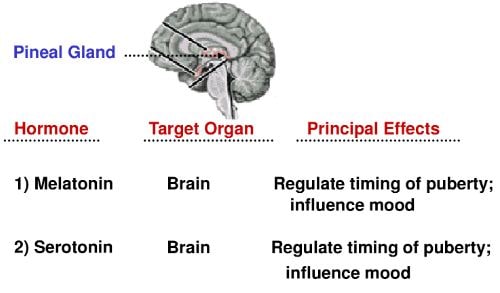
7- Pineal Gland
It is a pea-sized conical mass of tissue behind the 3rd ventricle of the brain which secretes a hormone in some mammals. It is located near the center of the brain, produces the melatonin hormone, which helps to regulate the sleep and wake cycle in humans thus regulating sleep patterns. Sleep patterns are also called circadian rhythms.
8- Pancreas
The pancreas is a glandular organ in the upper abdomen, but it actually serves as two glands in one: a digestive exocrine gland and a hormone-producing endocrine gland. Functioning as an exocrine gland, the pancreas excretes enzymes to break down proteins, lipids, carbohydrates and nucleic acids in food. Functioning as an endocrine gland, the pancreas secretes the hormones insulin and glucagon to control blood sugar levels throughout the day. Both diverse functions are vital for the survival of the body.
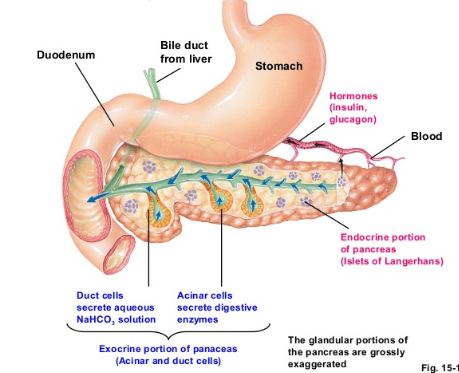
Role of the pancreas in the endocrine system
Homeostasis of blood glucose
The endocrine portion of the pancreas controls glucose homeostasis in the bloodstream. Blood glucose levels must be kept within certain limits so that there is a constant supply of glucose to feed the body’s cells, but not so much that glucose can damage the kidneys and other organs.
The pancreas produces 2 antagonistic hormones to control blood sugar: glucagon and insulin.
- Glucagon: Alpha cells in the pancreas produce glucagon. Glucagon increases blood glucose levels by stimulating the liver to metabolize glycogen into glucose molecules and release glucose into the blood. Glucagon also stimulates adipose tissue to metabolize triglycerides in glucose and release glucose in the blood.
- Insulin is produced by beta cells in the pancreas. This hormone reduces blood glucose levels after a meal by stimulating the absorption of glucose by the liver, muscles and adipose tissues. Insulin triggers the formation of glycogen in the muscles and liver and triglycerides in adipose tissue to store absorbed glucose.
Endocrine system diseases
There are many disorders that may affect the endocrine system, and cause an increase or decrease in the secretion of their hormones, some of which do not affect their secretion, and the most prominent diseases of the endocrine system are shown below.
- Diabetes ( in English: Diabetes): It is a more common endocrine disease in the United States of America. Cushing’s disease, which is the overactive adrenal glands.
- Adrenal insufficiency: This condition is represented by a decrease in cortisol secretion from the adrenal glands, and the secretion of aldosterone may also decrease in some cases.
- Hyperthyroidism: This causes the patient to feel many symptoms, such as weight loss, sweating, nervousness, and a fast heartbeat.
- Thyroid deficiency ( in English: Hypothyroidism): This disorder may cause slow growth of children, as the patient may suffer from constant fatigue, constipation, dry skin.
- . Gigantism: This condition is caused by increased secretion of growth hormone.
- Polycystic ovary syndrome: This syndrome includes hyper androgen production.
- Multiple endocrine neoplasia: A group of tumors affecting the thyroid glands, parathyroid and adrenal neighbors, which causes increased secretion of hormones, and these tumors are rare genetic disorders.
